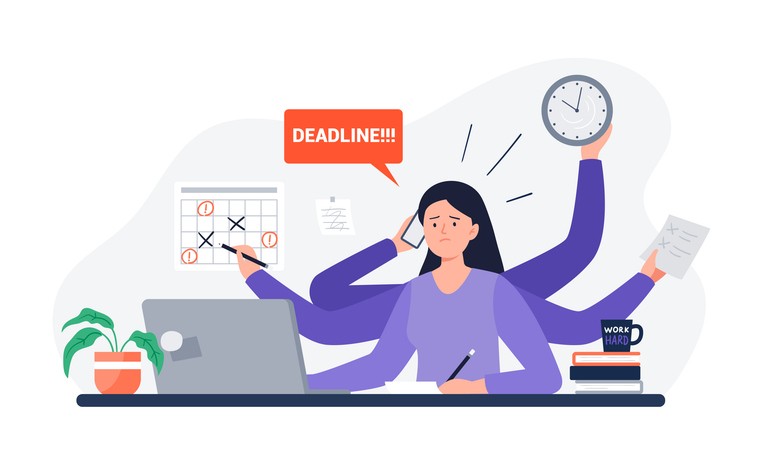
A Work Anxiety Solution You Can Actually Use
Even on Your Most Tired Days
You already know the drill: the inbox piles up, the meeting invite lands, and suddenly your heart is beating like you just sprinted a marathon. Work anxiety doesn't ask for permission—it just shows up.
And honestly? Most of us are too tired to wage an endless war against it. We don't need another "5 AM miracle routine." We need something that actually works when we're running on fumes and still expected to deliver.
Here's the good news: you can train calm under pressure the same way you'd train a muscle. It doesn't mean your brain stops sending "what if" alarms—it means you stop letting those alarms drive the car.
Why Work Anxiety Feels So Heavy
Anxiety isn't weakness—it's your brain's survival system misfiring. The amygdala screams "danger" at a missed email the same way it would at a tiger. Meanwhile, your prefrontal cortex—the part that helps you plan and think clearly—shuts down under high stress.
That's why you blank in presentations or spiral before deadlines. It's not you "being bad at your job." It's biology.
But biology is also hackable. With small, repeatable skills, you can retrain your nervous system to stay steady in high-stakes moments. If presentation anxiety is your specific challenge, explore proven calming approaches that work even when you're exhausted.
Three Skills That Quiet Work Anxiety (Without Burning You Out)
Name the Bias, Break the Spiral
Work anxiety often comes from cognitive biases—shortcuts your brain takes that backfire.
- Spotlight Effect: You assume everyone's judging your every word in meetings.
- Planning Fallacy: You underestimate how long projects take, then panic when you're behind.
👉 Hack: Call out the bias out loud—or in your notes. "This is my spotlight effect talking." Naming it gives you just enough distance to choose a calmer response.
Anchor in the Present (90 Seconds at a Time)
Stress chemicals from anxiety only last about 90 seconds in your body. It's the racing thoughts that keep hitting the "snooze" button.
👉 Hack: Try the 4-7-8 breath—inhale 4, hold 7, exhale 8. It forces your body into parasympathetic calm. Three rounds takes less than a minute and buys back focus.
Use Future Focus to Shrink the Threat
Anxiety = overestimating the threat ÷ underestimating your ability to cope.
Instead of asking, "What if I fail?", flip it: "What will it look like if I handle this well?"
👉 Hack: Do a "future snapshot." Imagine yourself at the end of the week, having navigated the situation. This primes your brain to notice pathways forward, not just dead ends.
What's In It For You (WIIFM)
- Cut the decision lag. When you're calm under pressure, you stop wasting hours in overthinking loops.
- Protect your evenings. Anxiety drains energy that should be yours after work. When work follows you home, boundaries need attention.
- Build trust at work. Colleagues notice composure—it signals competence more than perfection ever will.
Think of it as ROI on your mental energy: a 3-minute reset that saves you hours of spiraling.
Try This Tiny Habit This Week
When anxiety spikes at work:
IF I notice my chest tighten, THEN I'll do three rounds of 4-7-8 breath.
IF my brain screams "everyone noticed that mistake," THEN I'll write down the bias ("spotlight effect") and reframe.
Small, repeatable actions compound over time. You don't need to conquer anxiety in one heroic act—you need micro-wins that stick.
Multi-Path Options (Because One-Size Doesn't Fit All)
Cognitive Pathway
Learn to spot unhelpful thoughts and swap in balanced ones
Skill Pathway
Practice stress resets (like breathwork or grounding) to train your body out of panic mode
ND-Affirming Pathway
If you're neurodivergent, masking at work may drain you faster. Adapt these tools (shorter breath cycles, sensory grounding) so they don't add to the load.
Environmental Pathway
Sometimes it's not "your mindset"—it's workload design. Push back on unrealistic timelines. The WEF report shows healthier workplaces boost both well-being and productivity.
Final Word (From One Tired Professional to Another)
You don't need to become fearless. You just need to get through the meeting, the project, the day—with a little less adrenaline and a little more air in your lungs.
Calm under pressure isn't a miracle cure. It's a skill. And tired as you may be, it's one you can start practicing right now.
Start Your Free 30-Minute Reset
Each 30-minute reset leaves you with something new in your pocket. Relief now, plus a tool you can keep using.














